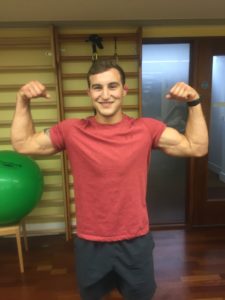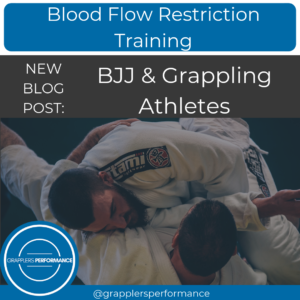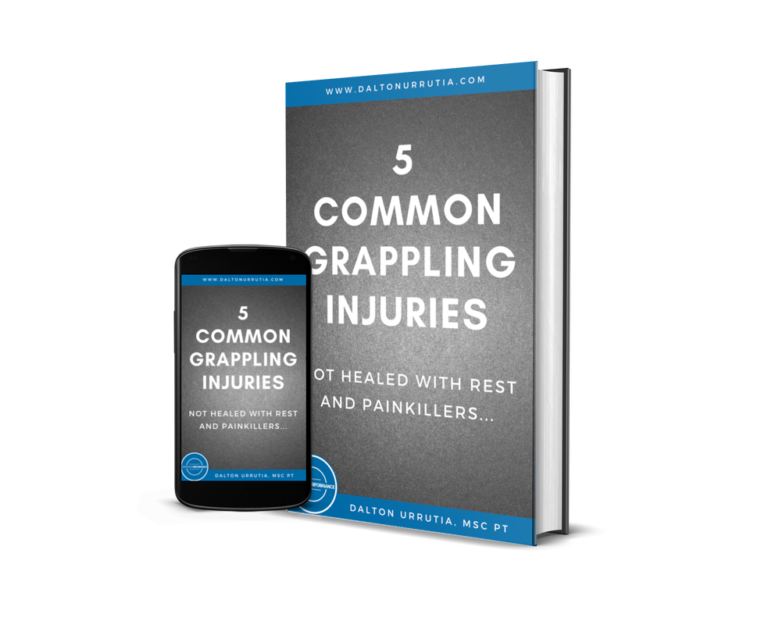Blood Flow Restriction Training Explained…
What Does The Research Say?

Blood Flow Restriction Training is the next big thing in sports performance and rehab realm. Actually, it is already here.
Put simply, blood flow restriction, or BFR for short, is the use of cuffs to temporarily restrict blood flow while exercising. While this may seem odd, the benefits are pretty spectacular, especially when looking to build strength without using heavy weights, or rehab injuries.
A growing body of evidence is consistently showing remarkably strong evidence for the use of BFR.
So, what does it do?
This post will summarize the most recent and robust evidence to answer the following:
- What is BFR?
- How does BFR work?
- How do you use BFR?
- Is BFR Safe?
- Is BFR Useful for BJJ and Grappling Athletes?
What is BFR ?

The evidence now supports BFR combined with low-load (20-40% of your 1 rep maximum) resistance exercise, can enhance morphological strength response(1).
While the physiological mechanisms at work are not yet fully understood, BFR can enhance muscular responses without high mechanical loads.
This is applicable both in athletic and clinical rehab populations.
However, the pressure used and restricted blood flow, must be used correctly to get the appropriate response.
For example, If the restrictive pressure is too low, muscular responses may not be significantly stimulated (1).
On the other hand, extremely high pressures may not enhance muscular development more than moderate pressures, and can be a safety concern (1).
The results sound great, but, how does BFR work?
Next up, the potential mechanisms at play will be covered, as well as how to use BFR most effectively.
How Does BFR Work ?

BFR causes muscular hypertrophy and strength benefits in both untrained and athletic populations.
These adaptive responses have been repeatedly demonstrated, however, the mechanisms responsible are still not well understood.
High level research (1) has proposed that downstream of the BFR cuff, accumulation of metabolites may cause an anabolic response, due to 2 things;
First, the increased production of metabolites due to the lack of blood flow and oxygen to the muscles.
Second, the limited removal, due to the BFR itself restricting venous return.
Most importantly, this accumulation of metabolites may increase a few things.
First, muscle cell swelling.
Second, intramuscular anabolic/ anti-catabolic signaling.
Third, muscle fiber recruitment.
All of which are thought to be beneficial for muscular adaptation.
Also, BFR may increase the activation and proliferation of myogenic stem cells, enhancing the hypertrophic response.
Although there is growing interest in the mechanisms of BFR, the physiological processes involved are not well understood and further research is required.
That being said, it is now well acknowledged that BFR can enhance the adaptive responses to low-load resistance exercise. However, the adaptations seen, are dependent on both the BFR stimulus itself and the exercise protocol performed.
Now that we have an idea of how BFR might work, next lets looks at how to use BFR.
How to Use BFR?

BFR is most commonly used with a cuff placed high up the arm or high up the leg/thigh.
There are 3 main things to consider with the use of BFR:
- Cuff Type and Application
- Restrictive Pressures and % of Blood Flow
- Exercise Type and Protocol
The research supports the use of specific pressures in specific positions and specific exercise protocols to get the best results (1)(2).
1. Cuff Type and Application:

One of the most important factors to consider when applying BFR is the width of the cuff.
Researchers have used a range of cuff widths for:
Legs (4.5–18.5 cm).
Arms (3–12 cm).
Wider cuffs (13.5 cm) can increase ratings of pain and perceived exertion and limit exercise volume when compared with narrow cuffs (5.0 cm) inflated to the same restrictive pressure.
Wider cuffs (13.5 cm) transmit pressure through soft tissue differently to narrow cuffs and restrict arterial blood flow at lower pressures vs. narrow cuffs (5.0 cm), which may increase safety.
Limbs with a larger circumference require higher occlusive pressures to reach the same level of arterial occlusion. For example, using BFR on the legs will take more restrictive pressure than on the arms.
2. Restrictive Pressures and % of Blood Flow

BFR pressure should be high enough to occlude venous return, yet low enough to maintain arterial flow into the muscle.
First off, commonly BFR is implemented with a percentage of estimated total arterial occlusion pressure (TOP)
(TOP) is the amount of pressure applied through the cuff to completely block arterial blood flow. Arterial blood flow is the blood going away from the heart to the body.
This is extremely important because, BFR pressure should, one, vary relative to each individual, and two, be dependent on cuff width and the size of the limb.
For example, BFR pressure SHOULD DIFFER when used on an adult bodybuilder versus an endurance athlete. This will be the case because, the bodybuilder will likely have larger limbs and would require higher pressures to achieve the desired blood flow restriction.
The most benefit comes with applying BFR at 50-80 % of (TOP). You would expect the following:
80 % – hypertrophic and strength responses similar to traditional high-load training.
50 % – maximize EMG amplitude and increase torque of low-load knee extension exercise
50 % – maximize acute muscle swelling and blood lactate responses.
Additionally, the most benefit occurs when the legs are occluded at 80% and the upper limbs at 50% (1)(2)(3).
Finally, to use BFR, you would occlude the limb to the appropriate level (50% or 80% of TOP) and perform low load exercise for the specific limb.
For example, push-ups for the upper limbs.
Now comes the questions of….How many should you do? What sets? What reps?
The research has shown very specific protocols to follow, which will be covered next.
Keep reading to see the best exercise protocol to use for maximal results.
3. Exercise Type and Protocol

The specific exercises to use can range, and can be very simple body weight exercises.
BFR alone can attenuate decrease in muscle mass and strength following surgery and non-weight bearing times (4).
Also, BFR is effective with light walking/cycling.
However, most use BFR in combination with low-load resistance exercises.
This has shown to cause a substantial increase in muscle mass and strength (1)(3).
When selecting an exercise protocol, consider the following.
TYPE OF EXERCISE:
Benefits can be seen with both single- and multi-joint exercises.
EXERCISE LOADS:
Use Low-load exercise (20–40 % of 1 rep maximum or Maximal Voluntary Contraction).
It is important to consider that multiple sets BFR exercise provides similar metabolic stimulus to high-load training, but may not replicate neural demands.
TRAINING VOLUME & REST:
50–80 repetitions per exercise.
Sets do not need to be performed to muscular failure.
Rest 30-45 sec between sets.The standard protocol for each exercises includes 4 sets, with reps of 30–15–15–15.
To ensure sufficient venous pooling, occlusion should be maintained during all 4 sets and rest times.
TRAINING FREQUENCY:
Clinical populations: 2–3 training sessions/wk.
Athletic populations: 2–4 sessions/wk; in addition to normal high-load resistance training.
Is BFR Safe?

When using BFR under the guidance of a certified professional, it is extremely safe and there are very low rates of adverse events. For example, one study in particular surveyed multiple facilities that regularly used BFR training (5). As a result, the most commonly reported side effects included light bruising of the skin and temporary light numbness during BFR.
More so, these were only experienced by 13.1% and 1.3 % of participants, respectively. This may put some people off BFR.
However, these symptoms are often discovered at the beginning of a BFR training program, and later on dissipate as the individual becomes more accustomed (1). Also, light bruising is easily prevented by using a sleeve/thing protective cloth under the tourniquet(6).
BFR is very safe for the majority of people. However, there are still some people where BFR should not be used.
You SHOULD NOT use BFR if you have any of the following contraindications(7)(8)(9)(10)(11);
History of deep-vein thrombosis
Pregnancy
Sickle Cell Anemia
Open wounds/Injuries
Varicose veins
Cardiac Disease
Rhabdomyolysis
Cancer
You CAN use BFR, but SHOULD BE CAREFUL AND MONITORED if you have the following precautions(6)(7)(8)(9)(10);
Subcutaneous hemorrhage
Circulatory problems
High Blood pressure and/or on Medication
Taking Creatine
Diabetes
Numbness
DOMS (Delayed Onset Muscle Soreness)
Nonetheless, when used in a controlled environment by trained and experienced personnel, BFR training appears to provide a safe training alternative for most individuals regardless of age and training status.
Simply put, BFR is safe if you are cautious and make sure you are healthy enough before use.
Next up and finally, is it Useful for BJJ and Grappling Athletes?
BFR for BJJ and Grappling Athletes

In essence, BFR can help most athletes via increased strength and muscle hypertrophy. Furthermore, BFR can improve strength and hypertrophy without subjecting your body and joints to heavy loads and intense exercise.
The most practical applications will be for BJJ and Grappling athletes whom fall under the following situations;
- Having a minor injury needing rehab / strengthening
- Post-operative rehab to speed recovery
- Don’t like heavy resistance training and still want to develop strength.
- Want to super-charge your current strength training program with light, low-load exercise.
Sound like you? You are in luck, and will most likely benefit from BFR training. However, to be safe and sure, here’s what the research says…
BENEFITS POST-INJURY/SURGERY (1):
The muscular adaptations to BFR training may benefit populations with compromised strength and/or joint stability.
BFR alone during periods of cast-immobilization can slow normal muscle wasting effects, and loss in strength. Additionally, further potentials include speeding up post-surgery recovery.
Also, BFR has been shown to stimulate strength and leg size gains during walking or cycling. Furthermore, both young and elderly experience these strength and muscle size increases following walk or cycle training with BFR.
BENEFITS FOR HEALTHY & ATHLETIC POPULATIONS (1):
Firstly, due to the low loads used and the limited muscle damage, athletes can benefit from decreased training loads. All the while, still gaining a physiological stimulus for muscular adaptation.
Similarly, athletes looking to increase their longevity in sport may benefit from the decreased mechanical stresses. A large amount of BJJ athletes are usually interested in training for longevity. Because BJJ and grappling sports tend to be ‘life-long’ sports, longevity matters even more in this population. The ability to build strength and prevent injury without having to do heavy weight training, could be beneficial for BJJ athletes, especially as they age.
Also, BFR adaptive responses enhance performance across a range of athletic tasks, including:
Maximum strength
Countermovement jump power
Maximal and repeated sprint performance
Agility performance
Aerobic shuttle run test.
Of these tests of fitness/strength, multiple have been shown to improve BJJ performance during training, sparring and competition (12).
Additionally, low-load BFR training benefits beginners and untrained individuals, as well as, already well-trained and veteran athletes. Because the stimulus is so unique, often, highly trained athletes still receive incredible results and benefit from BFR.
In simple conclusion
BFR is an intriguing and potentially useful tool to help BJJ and Grappling athletes. BFR has the potential to speed rehab, build strength without heavy weight training, and improve performance across training and competition. If you have aches and pains, want to build strength, or simply see if BFR can help you, find a health provider near you certified to deliver BFR training.
Grapplers Performance is a certified and registered business/health practitioner to deliver evidence based BFR.
Want to Learn More?
Contact Us!
SOURCES:
- Scott et al., (2014). Exercise with Blood Flow Restriction: An Updated Evidence-Based Approach for Enhanced Muscular Development. Sports Med. DOI 10.1007/s40279-014-0288-1
- Hughes et al., (2018). Influence and reliability of lower-limb arterial occlusion pressure at different body positions. PeerJ 6:e4697; DOI 10.7717/peerj.4697
- Wilson, J.P., et al. (2012). Low Intensity BFR Training: A Meta Analysis. Eur J Appl Physiol. 112(5), pp. 1849-1859.
- Kubota, Atsushi, et al. (2008). Prevention of disuse muscular weakness by restriction of blood flow. Medicine and science in Sports and exercise. 40(3), pp. 529-534.
- Nakajima, T., et al. (2006). Use and safety of KAATSU training:Results of a national survey. International Journal of Kaatsu Training Research. 2. 5-13. 10.3806/ijktr.2.5.
- Olivecrona, C., et al. (2012). Lower tourniquet cuff pressure reduces postoperative wound complications following TKA. J. Bone Joint Surgery. 94(24), pp. 2216-2221.
- AORN, (2014). Recommended Practice for use of Pneumatic Tourniquet in Pre-operative Practice Setting. AORN inc. pp. 183-208.
- McEwen, J.A., (2014). Tourniquet Use and Care. available at: www.tourniquets.org/use_care.
- Wakai, A., et al. (2001). Pneumatic tourniquets in extremity surgery. J. Am Acad. Ortho Surgeon. 9(5), pp. 345-351.
- Gupta, K., et al. (2008). Re-emphasizing the importance of tourniquet time: severe myocardial depression following tourniquet deflation. Acta Anesth Scandin. 52(6), pp. 873.
- Sheth, N.P.B., et al (2006). Rhabdomyolysis and acute renal failure following arthroscopic knee surgery in college football player taking creatine supplements. Clinical nephrology. 65(2), pp. 134-137.
- Karsten Øvretveit, Tiril Tøien., (2018). Maximal Strength Training Improves Strength Performance in Grapplers. Journal of Strength and Conditioning Research. 32(12), pp. 3326–3332

